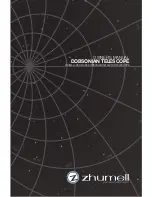
first time you go out at night. Pick a night
when the Moon is a crescent. No shadows
are seen during a full Moon, making it ap-
pear flat and uninteresting.
Look for different features on the Moon. The
most obvious features are craters. In fact
you can see craters within craters. Some
craters have bright lines about them. These
are called rays and are the result of material
thrown out of the crater when it was struck
by a colliding object. The dark areas on the
Moon are called maria and are composed of
lava from the period when the Moon still had
volcanic activity. You can also see mountain
ranges and fault lines on the Moon.
Use a neutral density filter (often called a
“moon filter”) when observing the Moon.
Neutral density filters are available from Me-
ade as an optional accessory and enhance
contrast to improve your observation of lunar
features. Spend several nights observing the
Moon. Some nights, the Moon is so bright
that it makes other objects in the sky difficult
to see. These are nights that are excellent
for lunar observation.
Observe the Solar System
: After observing
the Moon, you are ready to step up to the
next level of observation, the planets.
There are four planets that you can easily
observe in your telescope: Venus, Mars,
Jupiter and Saturn.
Nine planets (maybe more!) travel in a fairly
circular pattern around our Sun. Any system
of planets orbiting one or more stars is called
a solar system. Our Sun, by the way, is a
single, yellow dwarf star. It is average as far
as stars go and is a middle aged star.
Beyond the planets are clouds of comets, icy
planetoids and other debris left over from the
birth of our sun. Recently astronomers have
found large objects in this area and they may
increase the number of planets in our solar
system.
The four planets closest to the Sun are rocky
and are called the inner planets. Mercury,
Venus, Earth and Mars comprise the inner
planets. Venus and Mars can be easily seen
in your telescope.
Venus is seen before dawn or after sunset,
because it is close to the Sun. You can
observe Venus going through crescent
phases. But you cannot see any surface
detail on Venus because it has a very
thick atmosphere of gas.
When Mars is close to the Earth, you can
see some details on Mars, and sometimes
even Mars’ polar caps. But quite often, Mars
is further away and just appears as a red dot
with some dark lines crisscrossing it.
Jupiter, Saturn, Uranus, Neptune and Pluto
comprise the outer planets. These planets,
except for Pluto, are made mostly of gases
and are sometimes called gas giants. If they
7
Looking at or near the
Sun
will cause
irreversible
damage to your eye. Do not point this telescope at or near the Sun. Do not look through the telescope as it is moving.
Содержание Infinity 102
Страница 18: ...2014 Meade Instruments Corp...





























